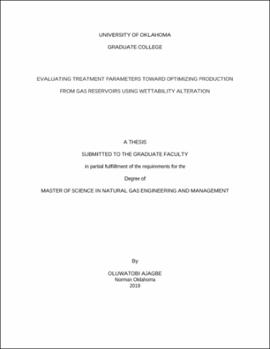| dc.contributor.advisor | Fahes, Mashhad | |
| dc.contributor.author | Ajagbe, Oluwatobi | |
| dc.date.accessioned | 2019-07-29T18:41:59Z | |
| dc.date.available | 2019-07-29T18:41:59Z | |
| dc.date.issued | 2019 | |
| dc.identifier.uri | https://hdl.handle.net/11244/321055 | |
| dc.description.abstract | Retrograde condensation in gas reservoirs results in a significant loss in well deliverability. A ring of condensate forms near the wellbore as a result of reservoir pressure falling below the dew point of the reservoir gas. Methods commonly used in the industry to alleviate this problem are temporary in nature, but the viability of permanent wettability alteration in the near-wellbore region has been steadily improving in recent years. Past studies in the use of wettability alteration to tackle the problem of retrograde condensation in a gas-condensate reservoir system have had three main focuses; experimental studies to develop chemical modifiers that will effectively adsorb onto the surface of the rock and alter the wettability of the pore walls, studies to ascertain the most effective wettability treatment in gas condensate reservoirs, and analysis of field application of wettability alteration treatments. There are only four known field applications, where two succeeded and two failed, although laboratory trials were encouraging.
In an attempt to understand factors that influence the performance of wettability alteration, a simulation model was developed that consist of combinations of radial reservoirs of various drainage radii, permeabilities, and containing one of three reservoir fluid types characterized by their condensate yields. We investigated the influence of various factors such as fluid types, reservoir permeability, reservoir size, and treatment radius, on the performance of different wettability treatments. Analysis of variance was carried out to ascertain the extent of statistical significance for the differential effect of various reservoir factors influencing the success of treatment.
We discovered that the success of wettability alteration is dependent upon the yield of the reservoir gas. A lean fluid is the least favorable to wettability alteration while a rich fluid is the most favorable. A low permeability reservoir would benefit more from wettability alteration treatment when compared to a high permeability reservoir. However, the larger the drainage area of a reservoir, the more improved production is achieved from a wettability alteration. In addition, a treatment resulting in a state of neutral wetting appeared to be the most effective treatment for a gas reservoir regardless of the condensate yield of the reservoir gas. In addition, we found out that while the main effect of certain factors appeared insignificant, their interaction with other factors is very significant. Small reservoirs seem to have better post-treatment recovery factors than large reservoirs.
The outcome of this integrated study is expected to serve as a footprint for the field application of wettability alteration treatment to alleviate the problem of condensate blockage in a gas reservoir. | en_US |
| dc.language | en | en_US |
| dc.rights | Attribution-ShareAlike 4.0 International | * |
| dc.rights.uri | https://creativecommons.org/licenses/by-sa/4.0/ | * |
| dc.subject | Engineering, Petroleum. | en_US |
| dc.subject | Gas Condensate Reservoir | en_US |
| dc.subject | Wettability Alteration | en_US |
| dc.subject | Enhanced Gas Recovery | en_US |
| dc.title | Evaluating Treatment Parameters Toward Optimizing Production From Gas Reservoirs Using Wettability Alteration | en_US |
| dc.contributor.committeeMember | Wu, Xingru | |
| dc.contributor.committeeMember | Karami Mirazizi, Hamidreza | |
| dc.date.manuscript | 2019-07-24 | |
| dc.thesis.degree | Master of Science in Natural Gas Engineering and Management | en_US |
| ou.group | Mewbourne College of Earth and Energy::Mewbourne School of Petroleum and Geological Engineering | en_US |

